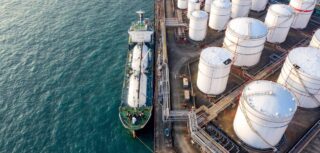- Resources
- 5 questions investors should ask about LNG projects
Resources
5 questions investors should ask about LNG projects
Published: October 13, 2022 by Andrew Howell
Russia’s invasion of Ukraine and ongoing disruptions to global energy markets underscore the urgency of accelerating the transition to renewable energy. Renewable power sources such as wind and solar can improve a country’s energy security as well as help meet climate goals, and European governments are determined to bring more clean energy online.
Still with Russia, a major oil and gas supplier, increasingly isolated from western buyers through pipeline failures and sanctions, coal power generation is seeing a resurgence. In the face of record profits and with encouragement from politicians, oil companies are raising exploration budgets. Pressure is rising on climate policies such as the U.K.’s ban on fracking.
Into this mix, energy companies, with the backing of the U.S. government, are proposing to increase North American natural gas production and invest in the infrastructure to export liquified natural gas (LNG). Doing so, they claim, would boost global energy security while securing climate benefits as well.
LNG: Climate solution or delusion?
Industry’s case for more LNG is straightforward: At the point of combustion, natural gas burns cleaner than coal. Avoiding a global transition from natural gas back to dirty coal is important to avoid the prospect of an increase in health- and climate-damaging pollution from coal-fired power generation.
In assessing the climate impacts of LNG, though, it’s crucial to account for emissions that occur before combustion — including during natural gas production, from pipelines and storage, during liquefaction, and in shipping and regasification.
Energy companies vary in their efforts to avoid methane leakage during the production and transport of natural gas. Significant leaks of methane, which has more than 80 times the warming power of carbon dioxide over the first 20 years after it reaches the atmosphere, can reduce or even negate the climate benefits of natural gas.
Supercooling natural gas to minus-260 degrees Fahrenheit to make LNG requires significant additional energy that erodes the overall climate benefits of the fuel, as does transporting it in specialized, refrigerated vessels. Some companies are working to develop certified low-emissions LNG that uses natural gas from producers with industry-leading emissions management practices and tracks cumulative emissions along the supply chain, but these efforts are at early stages.
The LNG supply chain:

While providing LNG to global markets may have near-term CO2 mitigation benefits by displacing coal in certain limited circumstances, natural gas will also need to be rapidly phased out as cleaner energy technologies scale up. Natural gas pipelines and export terminals are built to last for decades, but in its Net Zero Emissions scenario, the International Energy Agency forecasts that by 2050 the world should be using 55 percent less natural gas than it does today. Any natural gas infrastructure built today must be financed with an anticipated retirement date reflecting that timeline.
5 questions investors should ask about LNG
How should investors think about new LNG projects? These five questions can provide crucial insight:
- Can the project offer overall climate benefits? Most LNG projects will only deliver climate benefits if they 1) lead to the displacement of dirtier fuels, primarily coal, and 2) do not displace or delay the construction of new renewables. A project proposal should be clear about what other energy sources could be used in place of LNG and the relative climate and environmental impacts of each.
- Are supply chain emissions, particularly from methane, minimized? Gas for the project should be produced and transported according to best-in-class standards of methane monitoring, reporting and verification to achieve a near-zero methane emissions intensity. In assessing the project’s climate impacts, full supply chain emissions including from both methane leakage and energy usage should be considered when weighing the project’s risks and benefits. To ensure the credibility of reported data, operators should participate in best practice groups such as the Oil & Gas Methane Partnership.
- Would the project outlive its climate benefits? LNG capacity takes several years to build, and the transition to carbon-free energy is expected to drive future fossil fuel capacity retirements. A new LNG project envisioned today might not be operational until the end of this decade and may be displaced by cleaner energy in less than two decades. Projects should be designed and financed with climate-aligned retirement dates. Business models and paybacks should reflect the risk of reduced future use and early closure as renewables displace gas generation.
- Does the project respect local community concerns and priorities? Natural gas production and pipeline expansion have significant impacts on the communities in which they take place, and LNG export terminals have their own health and environmental impacts. Throughout the value chain, new natural gas infrastructure must be planned and built with respect for the needs and priorities of impacted communities.
- Do the project sponsors have strong climate goals and a history of responsible stewardship and policy advocacy? The best way to ensure that LNG is produced and transported with maximum climate benefit is through good practice supported by strong regulation. In the U.S., federal methane regulations being considered by the Environmental Protection Agency can set a baseline for emissions during natural gas production, while a proposal in the European Union would require emissions disclosure for natural gas imports to the continent. Developers, operators and financiers should all be active proponents of such a strong regulatory framework.
In responding to today’s energy shortage, investors, policymakers and the natural gas industry will shape emissions for decades to come. Stakeholders should use the opportunity to align new LNG facilities with energy, investment and climate goals.

